Bugs come in all shapes and sizes, but some of the most fascinating creatures in the insect world are those with an abundance of legs. From tiny millipedes to elusive house centipedes, these multi-legged critters capture our curiosity and sometimes even send shivers down our spines. In this article, we delve into the world of bugs with lots of legs and explore the top contenders. Join us in this exploration as we uncover the fascinating characteristics and behaviors of five leggy creatures that often find their way into our homes and gardens. Get ready to be amazed by the diversity and peculiarities of these extraordinary critters with an abundance of legs!
1. Millipedes
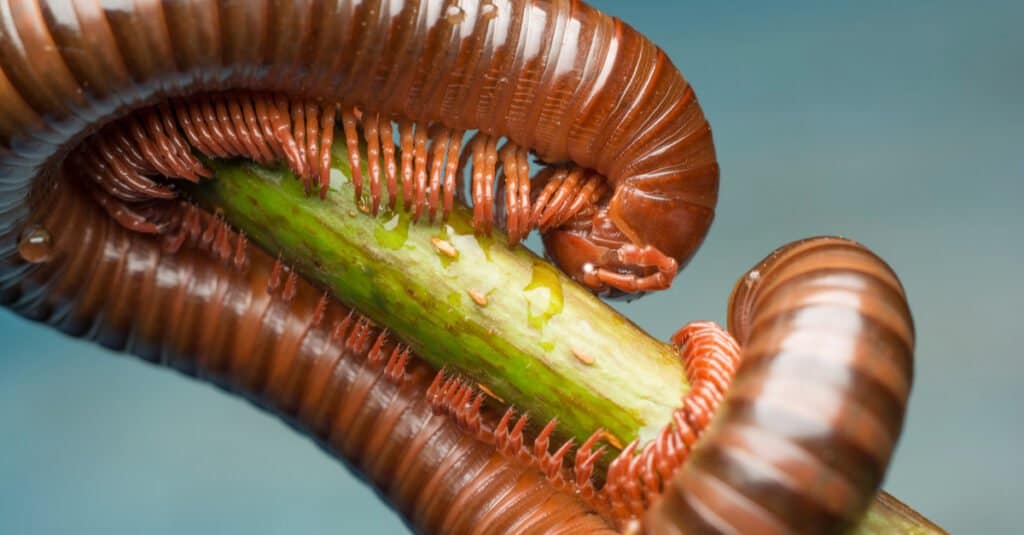
Millipedes do not bite or sting, but they do release a toxin to keep predators away.
©Piyapong pc/Shutterstock.com
With their multitude of legs and diverse adaptations, millipedes are captivating creatures that have found their niche in various ecosystems. By understanding and appreciating these remarkable arthropods, we gain a deeper appreciation for the intricate web of life that exists within our ecosystems.
Legs of a Millipede
Millipedes are renowned for their abundance of legs, but how many do they actually possess? Contrary to their name, millipedes do not possess a thousand legs. Instead, they typically have anywhere from 30 to over 400 legs, depending on the species. The number of legs varies between segments, with each segment bearing two pairs of legs. This impressive leg count allows millipedes to move with a distinctive creeping motion.
Appearance and Physical Characteristics
Millipedes have a unique appearance that sets them apart from other arthropods. Their elongated bodies are composed of numerous segments, each equipped with appendages and legs. The exoskeleton of millipedes is typically cylindrical, and they come in various colors, including shades of brown, black, and even vibrant hues. Some species possess defensive adaptations, such as the ability to curl up into a protective ball or secrete toxic substances as a deterrent.
Common Habitats of Millipedes
Millipedes can be found in a wide range of habitats across the globe. They thrive in moist environments such as forests, woodlands, and gardens. Leaf litter, decaying logs, and soil provide ideal conditions for millipedes to flourish. These arthropods are particularly abundant in areas with ample organic matter and moisture, as they rely on detritus for food and shelter.
Role of Millipedes in the Ecosystem
Millipedes play a crucial role in the ecosystem by contributing to nutrient cycling and soil health. As detritivores, they feed on decaying plant matter, breaking it down into smaller particles. This decomposition process aids in releasing nutrients back into the soil, making them accessible to other organisms. Additionally, millipedes help to aerate the soil as they burrow, enhancing its structure and facilitating water absorption.
2. House Centipedes
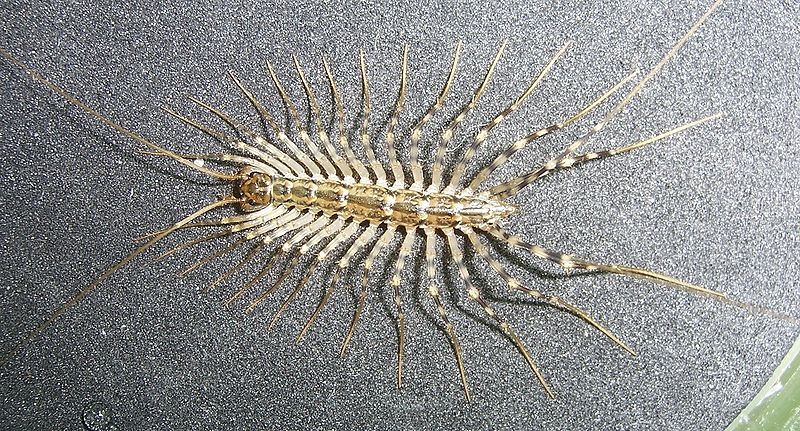
House centipedes have 30 legs.
©Dilcoe at English Wikipedia, Public domain, via Wikimedia Commons – License
With their numerous long legs and rapid movements, house centipedes often evoke a mix of curiosity and unease. These arthropods are fascinating creatures that inhabit various environments and fulfill important ecological roles. Let’s delve into the leg count of house centipedes, their appearance, common habitats, and the significant role they play in the ecosystem.
Leg Count of House Centipedes
House centipedes are renowned for their abundance of legs, which distinguishes them from other arthropods. On average, house centipedes possess 15 pairs of legs, totaling 30 legs. Each leg is long and slender, equipped with delicate appendages that aid in locomotion and sensory perception.
Appearance and Physical Characteristics
House centipedes have a unique and somewhat eerie appearance. They have elongated, flattened bodies consisting of numerous segments. Their bodies are typically brownish-yellow or grayish in color, and they have a pair of long antennae on their head. House centipedes also possess long, slender legs that are much longer than their bodies, giving them a swift and agile appearance.
Common Habitats of House Centipedes
House centipedes are primarily in damp and dark environments. They are often in basements, crawl spaces, bathrooms, and other areas with high humidity levels. These arthropods seek out sheltered nooks and crevices where they can find moisture and prey. House centipedes are commonly in homes, hence their name, but they can also inhabit outdoor areas with suitable conditions.
Role of House Centipedes in the Ecosystem
House centipedes fulfill an essential role in the ecosystem as predators. They play a significant part in controlling populations of other household pests, such as cockroaches, silverfish, spiders, and other small insects. House centipedes are highly agile and possess venomous appendages called forcipules, which they use to capture and immobilize their prey. By regulating populations of potential pests, house centipedes contribute to maintaining ecological balance.
3. Woodlice
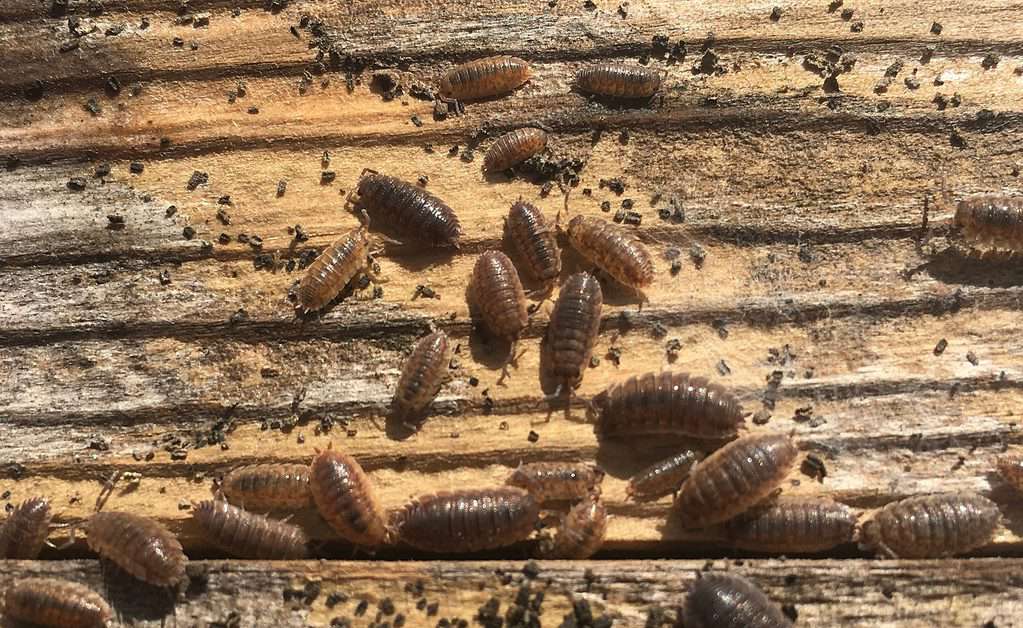
Adult and baby woodlice wood louse scattering after being disturbed.
©Ellianne/Shutterstock.com
Woodlice, also known as pill bugs or roly-polies, are intriguing arthropods that can be found in various environments around the world. With their unique ability to roll into a protective ball, woodlice have adapted to survive in diverse habitats. Let’s explore the leg count of woodlice, their appearance, common habitats, and the valuable role they play in the ecosystem.
Leg Count of Woodlice
Woodlice are characterized by their segmented bodies and numerous legs. On average, woodlice possess 14 legs. These legs are relatively short and sturdy, allowing them to navigate through their environment with ease.
Appearance and Physical Characteristics
Woodlice have a distinct appearance that sets them apart from other arthropods. They have oval-shaped bodies, consisting of several overlapping segments. Their bodies are typically dark or grayish-brown, and some species may display patterns or markings. Woodlice have two pairs of antennae on their head, which they use for sensory perception. Additionally, they have a hard exoskeleton that helps protect them from predators and environmental conditions.
Common Habitats of Woodlice
Woodlice are commonly in damp and dark environments, such as forests, gardens, and under decaying logs or rocks. They thrive in areas with high moisture levels, as their bodies are prone to desiccation. Woodlice are detritivores, feeding on decaying plant matter and other organic debris. They play a crucial role in nutrient cycling by breaking down dead plant material and returning valuable nutrients to the soil.
Role of Woodlice in the Ecosystem
Woodlice perform an essential role as decomposers in the ecosystem. They contribute to the breakdown of dead organic matter, accelerating the process of decomposition. By feeding on decaying plant material, woodlice helps release nutrients back into the soil, making them available for other organisms. They also serve as a food source for various predators, including birds, amphibians, and small mammals, further contributing to the overall biodiversity of their habitats.
4. Caterpillar
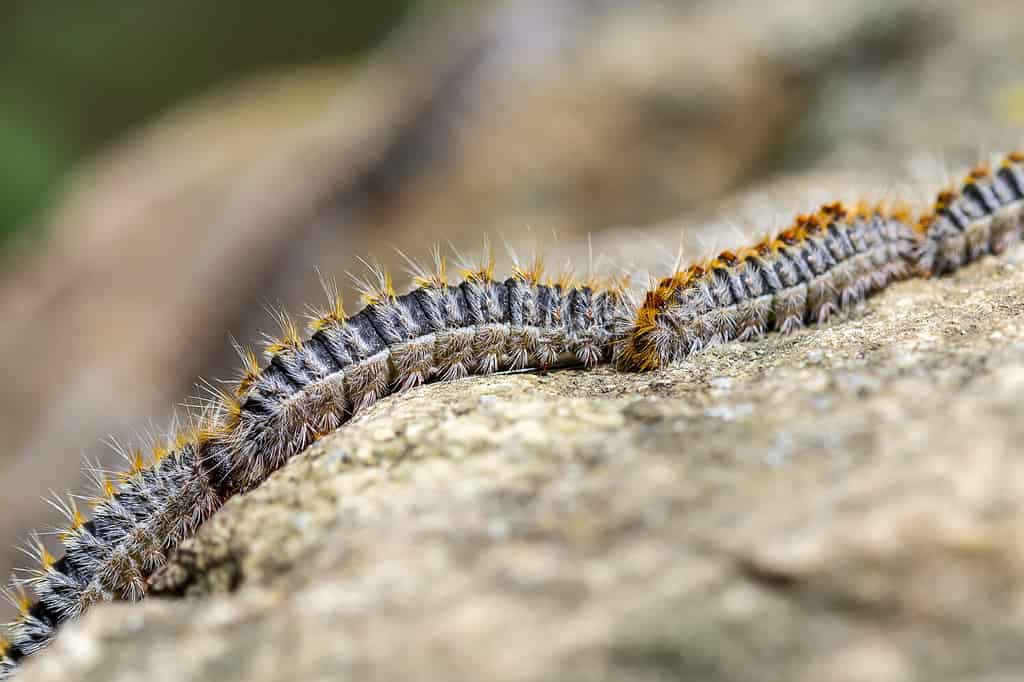
©Gonzalo Jara/Shutterstock.com
Caterpillars are fascinating creatures that undergo a remarkable transformation during their lifecycle. From their leg count and appearance to the role they play in the ecosystem, caterpillars hold a significant place in the natural world. Let’s explore all of this further!
Leg Count of Caterpillars
Caterpillars, the larval stage of butterflies and moths, typically have a total of 16 legs and prolegs. These “legs” are located on the thoracic segments of their segmented bodies. Each segment typically bears a pair of true legs, totaling 3 pairs or 6 total. Caterpillars then have additional appendages called prolegs, which are fleshy and equipped with tiny hooks for gripping surfaces, totaling 5 pairs or 10 total.
Metamorphosis: From Caterpillar to Butterfly
One of the most remarkable aspects of a caterpillar’s life is its ability to undergo metamorphosis. After a period of growth and feeding, the caterpillar enters the pupal stage, during which it undergoes a complete transformation. Inside the pupa, the caterpillar’s body breaks down, reorganizes, and reconstructs into the magnificent form of a butterfly or moth. During this process, the caterpillar’s legs are replaced by six jointed legs, which are characteristic of adult butterflies and moths.
Appearance and Physical Characteristics
Caterpillars display a wide range of appearances, depending on their species. They typically have elongated bodies with multiple segments, each adorned with distinct patterns, colors, and sometimes spines or hairs. Their bodies are soft and often cylindrical in shape. Caterpillars have a well-developed head with six simple eyes, known as ocelli, and a pair of antennae that help them sense their environment.
Common Habitats of Caterpillars
Caterpillars live in various habitats, including gardens, forests, meadows, and even urban areas. They are often on plants, where they feed voraciously on leaves, flowers, or fruits. Different species of caterpillars have specific plant preferences, with some being highly specialized, feeding on only one or a few plant species.
Role of Caterpillars in the Ecosystem
Caterpillars play a crucial role in the ecosystem. As herbivores, they consume plant material, which helps regulate plant populations and influence plant community dynamics. By feeding on leaves, caterpillars contribute to nutrient cycling and energy transfer within ecosystems. Additionally, caterpillars serve as a valuable food source for a variety of predators, including birds, insects, and small mammals, thereby contributing to the intricate web of life.
5. The Giant Centipede
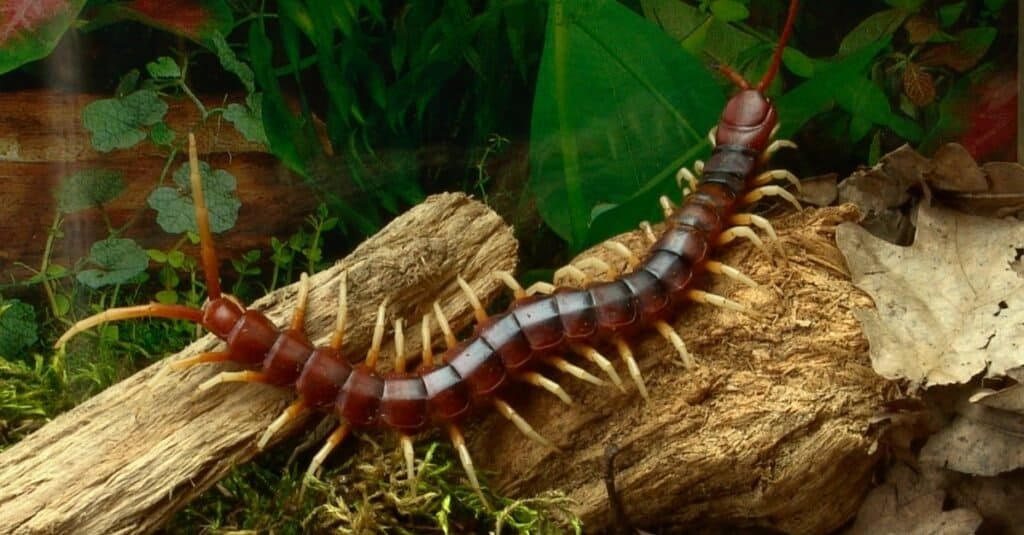
or the giant
centipede
is the largest centipede and can have up to 46 legs.
©skifbook/Shutterstock.com
The giant centipede, scientifically known as Scolopendra gigantea, is one of the largest species of centipedes in the world. It is also referred to as the Peruvian giant yellow-leg centipede or Amazonian giant centipede.
Giant Centipede Leg Count
The giant centipede has a long, segmented body with numerous pairs of legs. It can have anywhere from 21 to 23 pairs of legs, depending on its age and size. This means it can have up to 46 legs in total!
Appearance of the Giant Centipede
The giant centipede, Scolopendra gigantea, is impressively large and intimidating. It can grow up to 30 centimeters (12 inches) in length, making it one of the largest centipede species. The body of the giant centipede is long and segmented, with numerous pairs of legs. The body is typically dark brown or reddish-brown in color, with yellow or orange legs.
Habitat of the Giant Centipede
The giant centipede lives in a variety of habitats, including both dry and moist environments. It is often in sheltered places such as under logs, within leaf litter or soil, beneath rocks, and inside bark. It resides in various habitats, including urban areas, forests, woodlands, heath, rainforests, and deserts. The giant centipede prefers moist environments and is typically a nocturnal predator.
Role in the Ecosystem
Giant centipedes play an important role in their ecosystems as predators. They are carnivorous and feed on a variety of prey, including insects, snails, worms, and even small reptiles, amphibians, and mammals. By preying on these organisms, giant centipedes help control their populations and contribute to the balance of their natural habitats. They are beneficial predators in the ecosystems they inhabit.
It’s worth noting that the giant centipede is venomous and can deliver a painful bite. While the venom is not usually dangerous to humans, it can cause localized pain, swelling, and discomfort. The giant centipede generally avoids human contact and will only bite if threatened or provoked. If you encounter a giant centipede in the wild, it is best to observe it from a safe distance and avoid any unnecessary interactions.
In Conclusion
Bugs with an abundance of legs are not only fascinating but also incredibly diverse in the natural world. From the speedy centipede to the colorful millipede, these creatures play a vital role in our ecosystems. Their multitude of legs allows them to navigate their habitats with agility, hunt for food, and defend themselves against predators. While some of these leggy bugs might instill fear or disgust in humans, it’s essential to recognize their significance in maintaining the delicate balance of nature.
By understanding and appreciating these fascinating creatures, we can cultivate a deeper respect for the incredible biodiversity that surrounds us. So, the next time you encounter a bug with lots of legs, take a moment to observe its unique characteristics and marvel at the wonders of the natural world!
The photo featured at the top of this post is © iStock.com/ePhotocorp
Thank you for reading! Have some feedback for us? Contact the AZ Animals editorial team.







